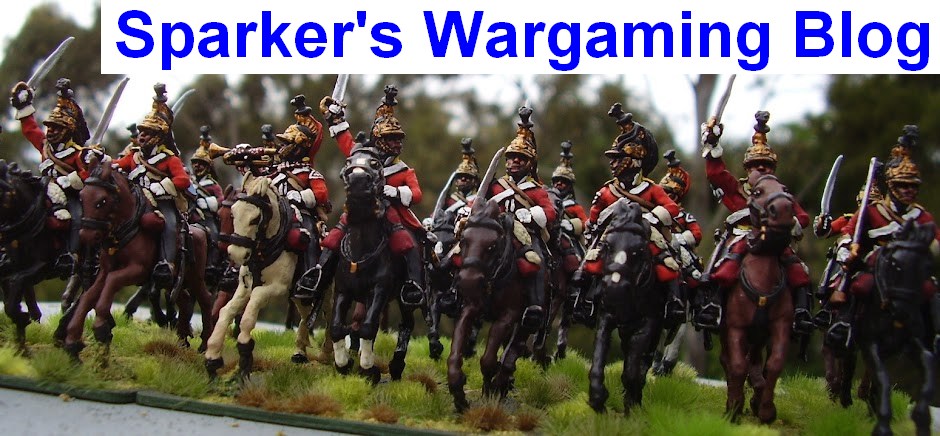In preparation for our forthcoming Waterloo mega-game, we wanted a large game to trial and test a few of the concepts involved. Using the excellent Valour & Fortitude rules with Epic scale figures, would we need to change the ground scale? How did the Orders of Battle look and feel? How would reinforcements arrive? Would sharing fate cards between Allies work?
For our trial we kept the full 28mm inspired ground scale, reasoning that, in line, there's little difference in size between an Epic battalion and their larger brethren. Off table reinforcements, and these were the majority of units in this scenario, would arrive using the Flames of War Immediate and Delayed Reserves system.
To test the arrival of a reinforcing army - the Prussians at Waterloo - we flipped Ligny so that, mysteriously unengaged at Quatre Bras, Wellington is able to come and help Blucher out...
With such an unfeasible large game crammed into an evening's play, we never got to see any infantry Delayed Reserves. So most of the later action revolved around clashes between various waves of light and heavy cavalry reinforcements at the NW end of the table.
However the game started with Vandamme's French Corps entirely on table, so the view from the Prussian side, with only a Landwehr Brigade garrisoning the villages and a Line Brigade in support, was daunting to say the least:
However, Cornelius the Prussian Commander, whose first game of V&F this was, did what he could to stem the French infantry onslaught!
At first the French horde seemed unstoppable...
With the French capturing St Amand for 3 VPs!
But nothing daunted, the Prussian's promptly counter-attacked!
Only to be rebuffed by the personal intervention of Marshal Ney who inspired the French Infantry to combat ferocity. Perhaps he was maddened by shame of his inaction at Quatre Bras?
However by this time both Prussian and British cavalry reinforcements shifted the centre of gravity of the action towards the western end of the table...
Leading with the renowned British LifeGuards Regiment of elite heavy cavalry, Wellington intervened with his habitual panache!
The LifeGuards charged the nearest Cuirassier unit...
Inspired, the Prussian Light Cavaliers also charged!
Under Wellington's eye, the initial charged smashed through the Cuirassiers! And the Prussian Light horse beat back the French Dragoons! But, Headstrong cavalry, they then charged on into the depths of the French heavy cavalry brigades, with inevitable results! However, with Light Dragoons now on scene...




















A very cool game and scenario there Ralph:)! It certainly looked excellent and really did have the feel of a lrage engagement. Just a shame that the clock ran out of time for the reserves to play their part. Maybe next time...
ReplyDeleteThank you Steve! Yes it has now occurred to me that after Waterloo, a 'proper' full scale Ligny might be in order...
DeleteWhat a lovey spectacle game and done as a ‘club night’ only adding to the reputation of V&F as a perfect wargame convention / show set of rules - which of course is exactly what they were designed to do.
ReplyDeleteYour group have made great strides on getting the forces towards being big enough for the planned mega game.
This is just a thought, but would you consider dropping a unit from 4 bases to 3 bases to get there a little faster? It just needs a few spare bases so that units going into square can revert to 4 bases, just so they look right / nice.
I often use two bases for Horse and Musket if I'm short of figures, they can still do line, column and for squares I just put them back to back (thank you Twilight of the Sun King for that idea!)
DeleteRalph meant to add that Anschluss Wargames are now doing a resin 12mm ISU 152 if you need those.
DeleteThank you for your kind comment Norm! Yes I do use 3 bases for my Epic ACW games as in that era there were few if any assault columns and squares. As Martin observes, 2 bases are a possibility for Napoleonics, and I have mooted that idea with a mate, but he pointed out that the raison d'etre of Epic scale is the visual impact of large units. And even in my 28mm days I reckoned fewer larger units have more visual impact than lots of small units...
DeleteThat is a very interesting take on Ligny. I've tried to game it many times and Tbh I still can't see how on earth Napoleon actually won in real life unless you nail half the Prussian army to table, which is a bit dull for the Prussians. The St Amanda sector is where all the fun is, and having Wellington actually turn up shows why Blucher put so much effort (and troops) into guarding the road to Quatre Bras.
ReplyDeleteThank you Martin! My initial attraction to Ligny is that I wasn't expecting the group to have much enthusiasm for painting Prussians and with Ligny you can get away with a lot of 'nominal' units garrisoning the various villages along the brook. And then the need to play test reinforcements meant the Anglo-Netherlands had to feed into the action...but it actually played through very well, particularly if you are into cavalry actions, as inevitably I assume the cav would be the first to arrive...
Delete